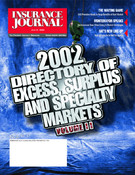Lloyd’s of London is perhaps the most well known insurer in the U.S., not only due to its 300 years of existence, but also because this country is the London market’s biggest customer, accounting for over 35 percent of its total gross premium income which reached $5.9 billion in 2000. Two activities—surplus lines and reinsurance—generated 84 percent of those revenues, each accounted for approximately $2.5 billion in gross written premium.
Despite last year’s unprecedented events and catastrophic losses—Lloyd’s, reporting on an annualized basis for the first time, indicated in April that it expected an overall loss for 2001 of around £3.11 billion ($4.65 billion)—Lloyd’s still managed some impressive gains. Total gross premiums rose to $20.4 billion, $7.1 billion from the U.S. Surplus lines gross premium in the U.S. rose to $3.3 billion, accounting for 47 percent of the U.S. book, while reinsurance premiums rose slightly to $2.8 billion, accounting for 39 percent of U.S. revenues.
“We’ll probably see gross written premiums, including surplus lines, continue that growth in 2002,” said Wendy Baker, president of Lloyd’s America, “but it’s really too early to give any formal estimates.”
While the Sept. 11 attacks stimulated some of that growth, Baker indicated that it is more deeply rooted than that. “I think the rates were going up even before September 11,” she said. “We’ve seen larger gains and more rate rises across all lines, and that will probably continue on through the rest of the year.”
Some surplus lines are more affected than others are. Sept. 11, Enron and other crises have all combined to greatly increase the demand in certain sectors, putting pressure on rates and causing premiums to rise. “We’ve probably seen higher increases in D&O, commercial property, medical malpractice and E&O lines,” said Baker. “Some of the rates [in those sectors] are much higher than in other lines.”
Putting all of this together pretty much verifies that hard market conditions are now dominant. For Lloyd’s and the rest of the industry that’s welcome news. “The last real hard market goes back to 1986-87,” said Baker. “The premium rises in the early 90’s were pretty much confined to “cats” [natural catastrophe coverage, following Hurricane Andrew], other sectors remained pretty depressed.”
Baker explained that the surplus lines market is significantly affected by the conditions of the insurance market in general. “During a hard market a proportion of business tends to move into the surplus lines market, as admitted carriers find they no longer want to write certain kinds of business.” She also observed that the reverse seems to be true in soft or weaker markets, when a number of insurers are actively seeking to increase business. “Then certain lines move back into the admitted market.”
For surplus lines underwriters this aspect is an intrinsic and very important part of their business. Lloyd’s is actually admitted as an insurer in only two states—Illinois and Kentucky—but it accepts business through its licensed brokers from every state in the Union. As more business flows into surplus lines, demand increases, premiums start going up, and underwriters are given greater flexibility in setting the terms and conditions of their policies.
“There’s been a definite return to risk selection and traditional underwriting methods,” said Baker. “Market share has become less important. Lloyd’s and other companies are examining risks carefully, asking how can we make it a ‘good’ risk?” The solutions, in addition to raising premiums, include a number of variables. Deductibles may be higher, policy limits may be lower, policyholders may be required to implement remedial programs aimed at eliminating potentially hazardous conditions which can increase claims and losses, and inevitably some coverage may be deemed too great a risk to underwrite.
This kind of flexibility is the most dynamic aspect of the surplus lines market. Policy forms, provisions and premium rates do not have to go through a regulatory approval process, and can therefore be more closely tailored to cover the individual risk involved. Lloyd’s global reputation was built on exactly that kind of underwriting, and it continues to be its greatest strength.
The terrifying events of Sept. 11 have made this clear. Before the attacks property policies covered claims from terrorism at practically no cost, as the risk was thought to be very low. That changed in a few hours. Many U.S. companies, and practically all of the world’s reinsurers, began excluding coverage for claims related to terrorism. Several Lloyd’s syndicates responded by setting up the first ever policy specifically designed to cover them. The U.S. government now insures a number of its embassies through Lloyd’s, and property owners in high-risk areas, such as New York’s Times Square, have also sought coverage for high profile properties.
Lloyd’s even covers the U.S. Army. When U.S. companies refused coverage against terrorist attacks on more than 10 high-risk military installations, the army turned to Lloyd’s. The policy, worth several million dollars, covers damage to buildings (but not equipment or personnel) caused by terrorist attacks, excluding chemical and nuclear weapons.
Lloyd’s surplus lines activities may not be regulated in the same way as automobile coverage or workers’ compensation are, but they are nonetheless supervised. The New York State Insurance Department administers a trust fund on behalf of the NAIC, which requires foreign carriers to deposit certain amounts to be held as a guarantee that funds will be available to pay claims. The funds are increased or decreased quarterly in accordance with the claims estimates.
For surplus lines Lloyd’s must deposit 30 percent of its estimated gross losses, a lesser percentage than the requirements for reinsurance which mandate a deposit of 100 percent . Lloyd’s came up with more than $5 billion to cover estimated Sept. 11 claims. “Our combined deposits [in the trust funds for surplus Lines and credit for reinsurance] is now around $10.9 billion,” said Baker. Although Lloyd’s can invest the money and keep the returns it makes, Baker observed that “we can’t invest in just anything, we’re regulated along the same lines as the [reserve and liquidity requirements for] domestic insurers.”
The question on everyone’s mind—in addition to Sept. 11, Enron and now WorldCom—is how long the hard market will last. Forecasts run from “it’s already over” to “at least the next few years.” Baker’s more or less in the latter camp. “Hopefully it will go on for several years,” she said. “I think it will, because a lot of people have lost a lot of money, and they need to come up with some earnings.”
She also indicated that the hard market conditions would tend to enforce existing broker relationships overall and in the surplus lines market. “London brokers have longstanding relationships with large, medium and small brokers in the U.S.; these often go back fifty or sixty years, and in a hard market people tend to want to do business with those they know and trust.”
The robust growth in surplus lines and those ties between Lloyd’s and the U.S. insurance industry explain the presence of Julian James, Lloyd’s director of Worldwide Markets, as the keynote speaker at the Western States Surplus Lines Association Annual Conference in Whistler Mountain, British Columbia July 25-28. James, who formerly headed Lloyd’s North American operations, can be expected to discuss current market conditions.
A recent study sponsored by Lloyd’s and the Association of Insurance and Risk Managers suggested that following the Sept. 11 attacks a “risk-averse” culture has developed that is stifling the aspirations of business and diminishing society’s capacity to respond to adversity.
It also suggests that since the attacks on the World Trade Center and the Pentagon an ever-growing part of social and business life has been reorganized around a heightened sense of security consciousness.
Commenting on the report James stated that, “This is a bold and worthwhile project that is setting out to ask fundamental questions about the way in which society has respondedto September 11. It will also consider the broader issue of how society and commerce in these formative years of the 21st century relates to the concept of risk. As an international insurer, we believe this project has the potential to be invaluable to our business; as members of society, we believe it could shed light on attitudes that will shape our lives for years to come.”
To comment on this story, e-mail: editorial@insurancejournal.com.
Topics Catastrophe USA Carriers Excess Surplus Reinsurance Market London Lloyd's
Was this article valuable?
Here are more articles you may enjoy.


 Allstate, Nationwide Post Dramatic Q12024 Homeowners Loss Ratio Drops: S&P
Allstate, Nationwide Post Dramatic Q12024 Homeowners Loss Ratio Drops: S&P  A $29 Billion Weed Market Fights to Diversify Amid Legal Hurdles
A $29 Billion Weed Market Fights to Diversify Amid Legal Hurdles  Let Good Adjusters, Not Expensive Lawyers, Make the Difference on Claims, CEO Says
Let Good Adjusters, Not Expensive Lawyers, Make the Difference on Claims, CEO Says  German Insurtech Wefox to Replace CEO After Board Rejects Mubadala Sales Plan
German Insurtech Wefox to Replace CEO After Board Rejects Mubadala Sales Plan 


